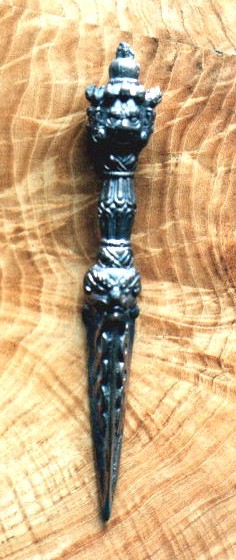
Bronze Phurba
This small bronze phurba is of the type which is often carried in the belt of a tantric yogi or yogini. It shows the three faces of Dorje Phurba and the makara’s head from which the three blades of the phurba emerge. This phurba was made in Tibet in the 19th century. The knotted design above and below the central lotus patterns of the handle are the unending knots which represent ‘the continuity of Vajrayana’. Tantra means ‘continuity’ – the continuity of emptiness throughout every manifestation of form. The phurba is known as the ‘dagger of emptiness’ and these knots emphasise the manner in which the action of the phurba is related to the empty quality of vajra nature. The entwined snakes on each blade are a symbol of the non-dual quality of form and emptiness which is apparent once attraction, aversion, and indifference have been impaled.
